Have you ever noticed that some blogs have a consistent voice no matter which page you read?
Take Kinsta, for example. Whether you’re interested in web hosting or becoming a technical writer, your experience rarely changes. You can tell it’s a Kinsta piece even if you remove all identifiable branding elements.
So, what do they use to achieve such harmony within their articles?
A style guide!
A 2020 Sprout Social report found that 40% of customers believe memorable content makes you stand out above the competition, and 33% think that a distinct brand voice makes a massive difference to your brand.
The standard AP stylebook can get you started and help you produce outstanding content for your blog. But that’s not enough on it’s own. You need a custom style guide to share a unique voice that speaks to your audience.
Read on to learn more about a writing style guide, how it helps your brand, and what you should include in yours:
Why Use a Style Guide?
A writing style guide ensures consistency across your communications. In other words, a style guide sees to it that you have a consistent brand voice and tone across all content assets: blogs, emails, reports, and social media interactions (for example, via Facebook and LinkedIn).
A style guide is a living document that provides guidelines and answers common questions a content creator has while crafting communications for your brand.
Benefits of a Writing Style Guide
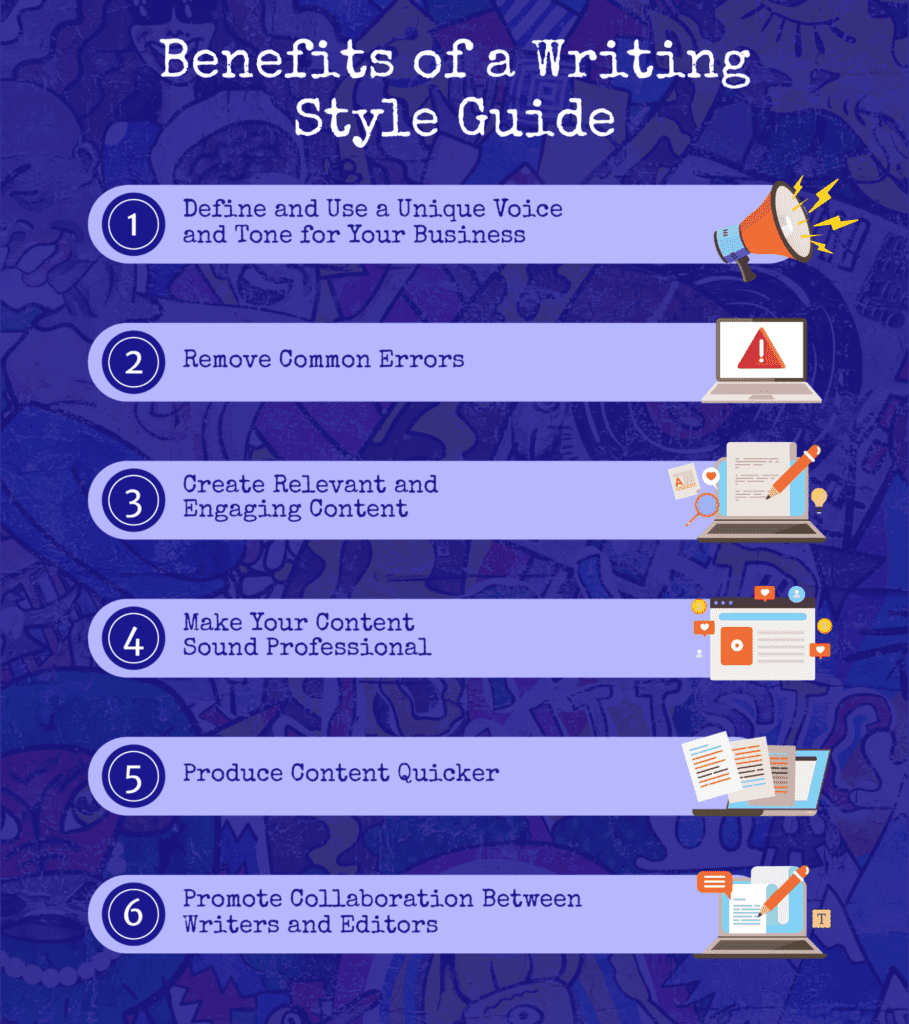
A writing style guide sums up the directions and guidelines surrounding your brand communications. But how does that help you?
Let’s dig in:
1. Define and Use a Unique Voice and Tone for Your Business
Your brand is much like a living entity your customers interact with. And that interaction decides whether the vibes match and the customers keep coming to your business.
In other words, your brand voice makes up your distinct brand personality that helps you build a lasting connection with the desired audience.
How does a writing style guide help you define your unique brand voice?
Depending on your product, service, or industry, a style guide enables you to choose and enforce an appropriate voice across your brand communication for your target audience. It helps your audience relate to you and take the action you want since your content sounds “right.”
What about tone?
A style guide can help set an ideal tone for your business.
Nielsen Norman Group’s The Four Dimensions of Tone of Voice is an excellent place to start defining your brand-specific tone.
There are four dimensions:
- Funny vs. serious: Are you trying to come off as humorous, or is your brand more serious?
- Formal vs. casual: Do you want your communications to be formal or casual? Most times, casual and conversational go hand-in-hand for a general audience.
- Respectful vs. irreverent: Are you communicating in a respectful or irreverent way? Although irreverence can set you apart from your competitors, be careful not to come across as offensive to your readers.
- Enthusiastic vs. matter-of-fact: Do you want the writers to use a fun and upbeat tone in your communications? A matter-of-fact approach might help you sound more authentic if your content is factual.
2. Remove Common Errors
Use your own style guide to get rid of many common errors before they find their way into the first draft. This saves you time and resources during the editing process.
For instance, you can share notes on punctuation, common wrong phrases, and frequently misspelled words in your industry. Even proficient writers and editors can make mistakes or forget a rule, so an easy-to-reference style guide can go a long way in improving content quality.
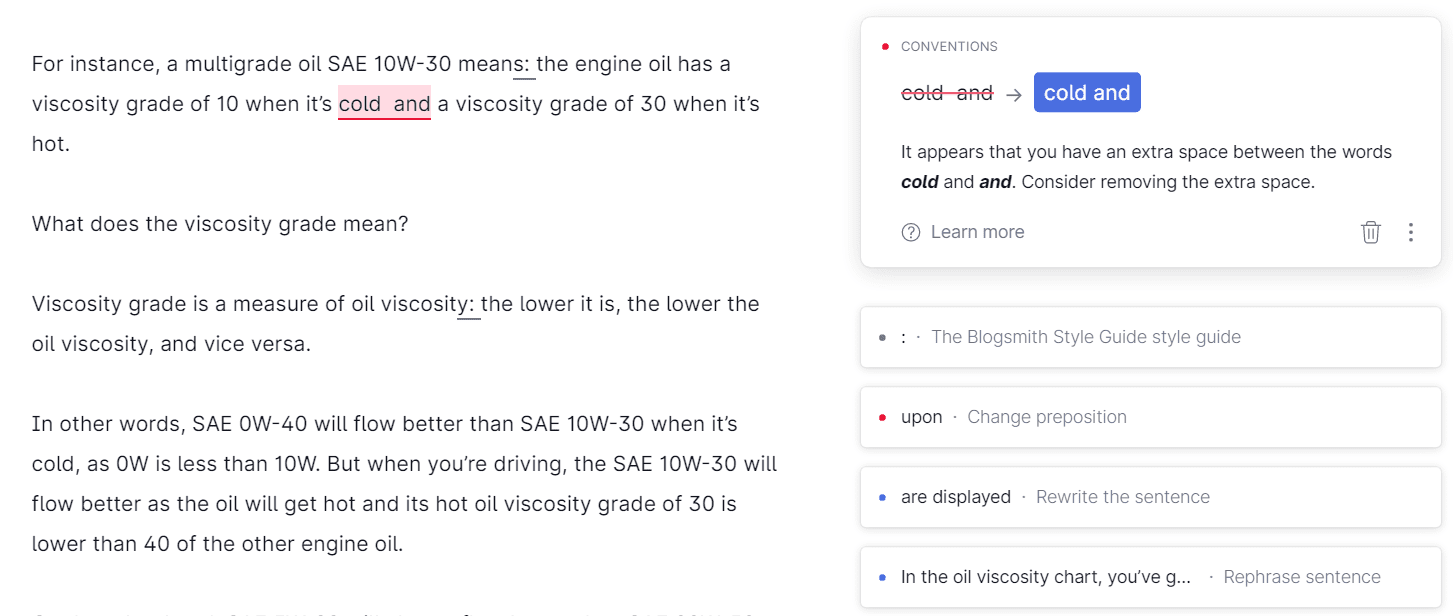
You can also make tools an integral part of your style guide. For example, Grammarly helps cut plenty of grammatical mistakes from your content. It also comes in handy when dealing with hyphens, Oxford commas, spacing, and abbreviations.
On top of that, you can integrate your style guide with Grammarly to get custom suggestions for your everyday content:
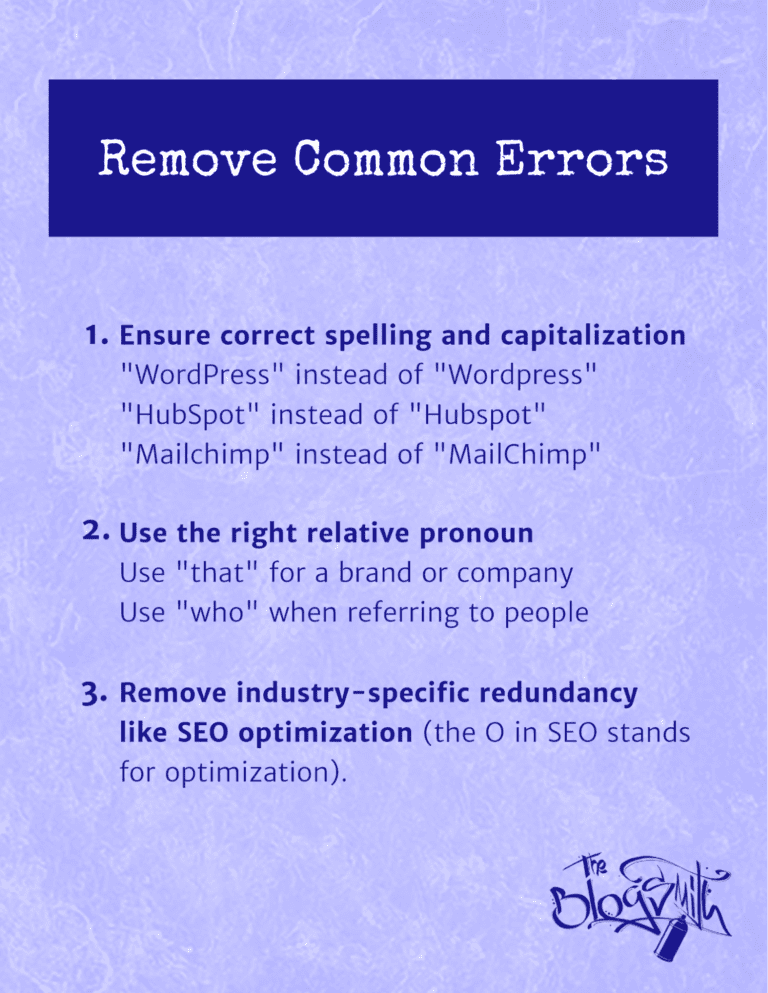
Besides Grammarly, you can also use the Hemingway App to improve readability and tools like MarketMuse and Clearscope to optimize your content for search engines.
3. Create Relevant and Engaging Content
A style guide helps align brand identity with your business goals and objectives. It does so by helping your writers focus on the brand message while telling stories that draw your ideal customer in.
For instance, you can make your content engaging by including brand guidelines surrounding:
- Supporting images and graphics that enhance the message of your written content. This includes colors, logos, and fonts.
- Expert sources, research, and statistics you’d like to include in your articles and written communications.
- Internal and external links.
4. Make Your Content Sound Professional
A key marker of professional content is consistency, and a writing style guide helps achieve that across your blogs.
You can include preferred spellings and variations to ensure all writers and editors create content with a similar brand voice.
For example, various content creators handle terms like IaaS, SaaS, and PaaS differently. However, Liquid Web consistently writes these as:
- Infrastructure-as-a-Service
- Software-as-a-Service
- Platform-as-a-Service
Similarly, you can share a set of standards for your designers to follow — which logo to use with a black background, which colors to prefer in the featured image, and so on.
5. Produce Content Quicker
A brand style guide helps your writers produce content faster since it gives them a clear roadmap of what to do and what to avoid.
For instance, your style guide might contain outline templates for different article types. These outline templates help you speed up the content creation process since you don’t have to reinvent the wheel.
6. Promote Collaboration Between Writers and Editors

A writing style guide helps create a collaborative relationship among your team members. First, your writers use it as a guideline for preparing blogs and other communications. Second, your editors can use it as a benchmark for that content.
Besides that, your editors can use the style guide to communicate expectations to writers, making the editing process straightforward and less personal. Writers will be more willing to take feedback from their editors if a style guide is in place.
Writing Style Guide Checklist: What You Need To Include
What should your style guide contain?
Here’s a checklist for what to include:
Personas
A persona refers to a representation of ideal customers who share goals, buyer journeys, and personal characteristics. Personas simplify marketing to that chosen group of buyers and help you create better content for different audiences. They help your writers visualize the target audience and find ways to relate to its members and speak their language.
In this way, you can develop content for readers with different backgrounds and still manage to focus on their pain points and get them to convert.
Grammar
A set of rules for grammar is essential in your style guide. It helps you create consistent content. Besides, proper grammar and capitalization make your writing come across as more professional.
Language is fluid, and sometimes, you need to break some rules. A comprehensive style guide can help determine which rules to break or ignore in your content. This adds variety and a human touch to make your writing feel natural to the reader.
Preferred Style, Spellings, and Tone
Include your preferences. Even though the English language is pretty standard across the board, certain words, phrases, and expressions may sound strange or inappropriate to certain audiences.
A corporate style guide should have rules that help you relate to the audience. For instance, you may use American English for an American audience and British English for a British audience.
Industry Jargon and Terminology
Provide your writers with the relevant industry jargon and terminology. Ensure they also have the appropriate definitions to understand how to use them in the proper context. This is essential since making common mistakes will hurt your credibility.
Also, share guidelines for jargon. If you’re targeting a general audience, you may need to limit the use of technical language. However, if the readers are experts in that field, you may need to incorporate jargon to gain their trust and show an ability to speak their language.
Guidelines on Images and Graphics
Ensure you have guidelines and design standards for graphics and images to provide a consistent brand experience.
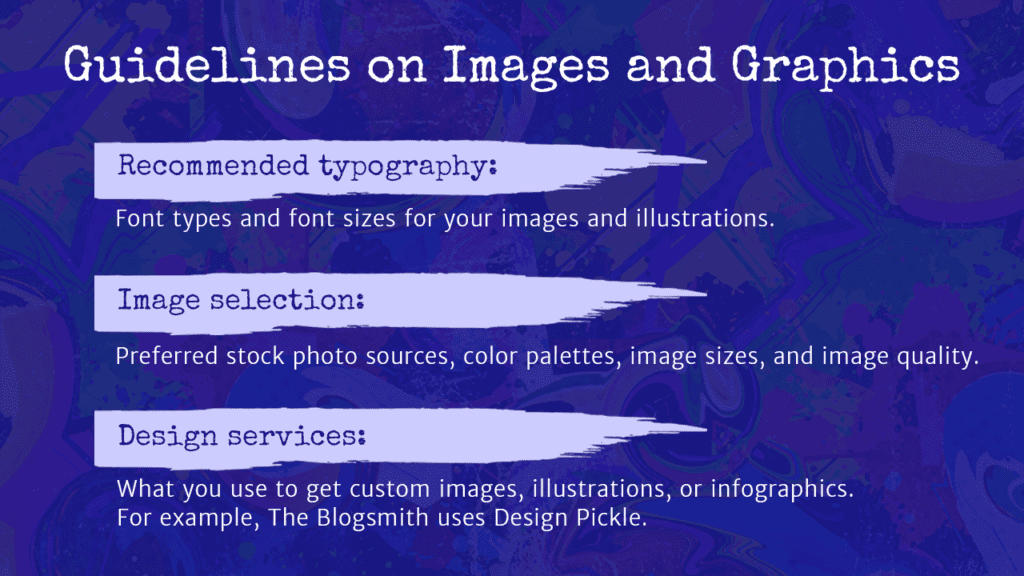
For example, include details like:
- Recommended typography: Font types and font sizes for your images and illustrations.
- Image selection: Preferred stock photo sources, color palettes, image sizes, and image quality.
- Design services: What you use to get custom images, illustrations, or infographics. For example, The Blogsmith uses Design Pickle and our internal designers.
SEO Best Practices
Ensure your editorial style guide addresses internal SEO best practices for content.
For instance, you can include guidelines to optimize content for search engines:
- Headings: How to incorporate primary and secondary keywords.
- Images: How to write effective alternate text.
- Links: How to source internal and external links and text hyperlinking best practices.
- SEO titles and meta descriptions: How to apply best practices for SEO titles and meta descriptions.
Search Intent
Ensure your style guide directs your writers to assess the search intent of a keyword before producing content. Doing so ensures you produce useful and relevant content.
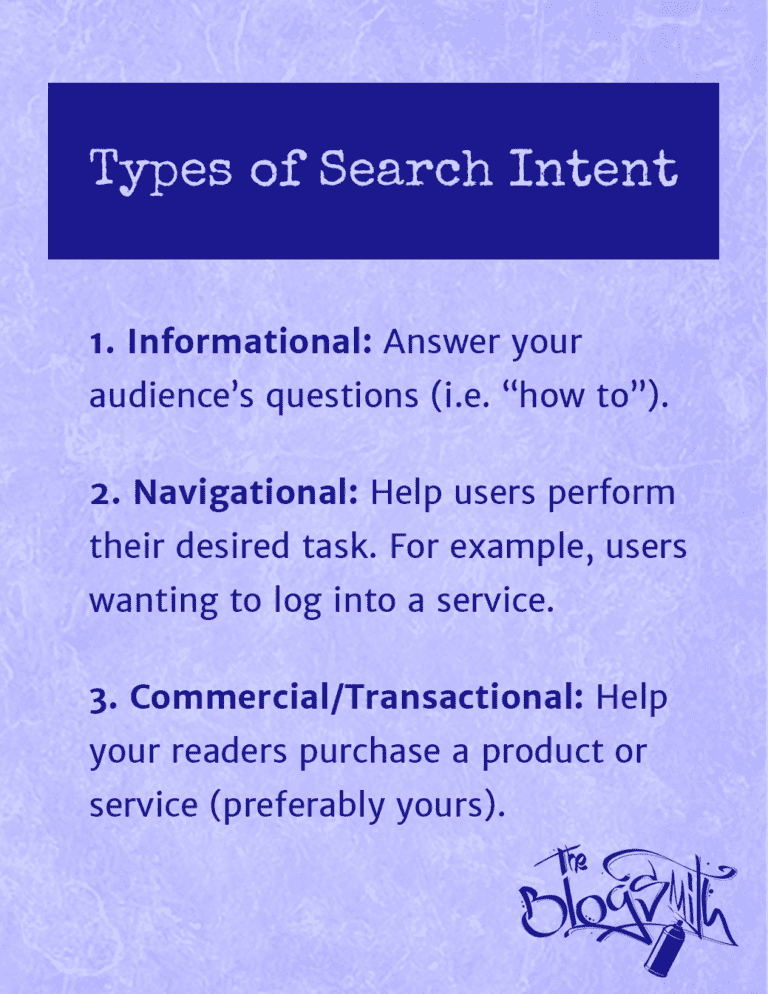
There are three types of search intent:
- Informational: Answer your audience’s questions (i.e., “how to”).
- Navigational: Help users perform their desired task. For example, users wanting to log into a service.
- Commercial/Transactional: Help your readers purchase a product or service (preferably yours).
Fact-Checking
Ensure you have guidelines on how to fact-check content. Fact-checking helps you keep your content unbiased, honest, and respectful.
Also, publishing content that’s consistently fact-checked helps you build your reputation and present yourself as an authority in the field.
Final Thoughts: 6 Ways a Writing Style Guide Can Improve Your Content
You need a writing style guide to level up your content and achieve consistency across your blog and brand communications. A style guide enables you to shape a unique brand voice and create content that keeps your audience engaged.
But the benefits of a style guide depend on what you include in it. Use the AP stylebook and our checklist to have a head start in creating a thorough writing style guide.
For more tips on creating a complete style guide for your brand, check out my book, Writing for Humans and Robots: The New Rules of Content Style. Get in touch if you need help creating your brand’s style guide.












